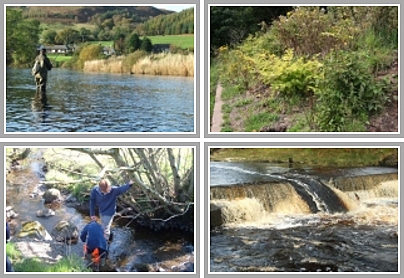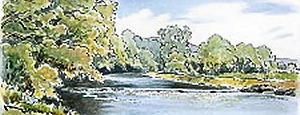We have had a bit of time to look at the 2025 timed electrofishing results in more detail and on the whole, spawning and survival from winter to July has been encouraging. Timed electrofishing is a rapid assessment of salmon fry survival between the spawning period and July when we survey across the same sites in each catchment each year. It is the least accurate of the assessments we perform however, it is ideal for determining overall trends and performance but it is in no way a quantitative assessment.
Results should never be compared between rivers as the habitat characteristics and issues affecting each of the 4 DSFB controlled rivers in Ayrshire is unique to each river and the individual sites.

Tarholm site was one of the most productive sites within the Ayr catchment
Across all sites surveyed on the Ayr catchment, timed results are up 58.4% on the 10 year mean with the average being 12.2 fry per minute in 2025. Results were the second highest since 2012 only beaten in 2017.

A really good bucket full of fry and a few parr from the Glenmuir site

Struan and Carolyn process fish at Auchendrane
Across the Doon catchment results are up 40.7% on the 10 year mean with the average of 19.7 fry per minute in 2025. These results are the second highest on record only beaten in 2013.

Two very substantial salmon parr from the lower river Doon

Merkland on the Girvan which often produces some of the best fry numbers of any site in Ayrshire
The Girvan results are up 3.9% on the 10 year mean with an average of 17.2 fry per minute in 2025. This is the best result since 2021 although it has often been higher than that previously.

Fry and parr from Enoch farm on the lower Girvan.

White Row near Aldinna on the upper Stinchar. Fry numbers were better than most years but no where near their peak.
The Stinchar results are up 34% on the 10 year mean with an average of 26 fry per minute in 2025. These are the best results since 2021.

While this is a fry survey, we also capture and record parr. These are healthy looking parr from Auchensoul.
We only found 3 sites across all the rivers that give us cause for concern and unexpected poor results. We will look into these more closely this year in order to try and understand why. There could be any number of reasons for abnormal results but we will attempt to rule out anything obvious such as pollution first.
All in all these results are encouraging and with all 4 rivers showing increased results in 2025, this follows a trend we see emerging every 4th year.
The trend across the Girvan and Stinchar are similar and appears to show a gradual decline that continues since 2012. The trend on both Doon and Ayr however, indicates a very slight improvement since 2012. Looking more closely at this, results indicate that Girvan and Stinchar fry numbers appear to fluctuate more widely than Ayr and Doon populations. We are currently unclear why this may be the case. Overall, the Doon is the most encouraging of these 4 local rivers at this time as it does appear to be improving although not as quickly as we would wish to see. However, as salmon numbers across Scotland have plummeted in recent years, it is notable that this river bucks the trend.

Ayrshire DSFB controlled rivers – Ave fry numbers with trend lines.
The 4 DSFB’s contribute to the Trust and we provide these assessments amongst many other services. Rivers out with the DSFB’s control are not assessed in this way. The Boards will receive a more detailed report once we complete a full review of the results.

